Suchergebnisse
Hausenergiezentrale mit Umweltenergie
Diese Hausenergiezentrale vereint Heizung, kontrollierte Wohnraumlüftung und Warmwasserversorgung auf Basis von Wärmepumpen in einem Gerät Dieses Projekt wurde nicht im Rahmen der Programmlinie "Haus der Zukunft" finanziert, leistet aber sehr wohl einen wichtigen Beitrag zur nachhaltigen Entwicklung.
URBAN STRAW - Brandschutztechnische Konditionierung von Einblas-Stroh zur Gebäudedämmung der urbanen Gebäudeklassen 4 und 5
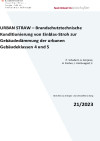
Entwicklung einer Brandschutzausrüstung von Strohhäcksel-Einblasdämmung zur Erzielung der Schwerentflammbarkeit anhand biogener Flammschutzmittel materialverwandter Stoffe und deren Applikationsverfahren. Anwendung des Materials als thermische Gebäudedämmung bei der Vorfertigung materialreduzierter Holzbauelemente für die urbanen Gebäudeklassen 4 und 5 mit bis zu 6 Geschossen.
Schriftenreihe
21/2023
P. Schubert, A. Korjenic, H. Fischer, I. Kirchengast, F. Hahn
Herausgeber: BMK
Deutsch, 76 Seiten
Downloads zur Publikation
Freiformflächen-Tageslichtsysteme für Fassaden und Oberlichter (FFF-TaliSys)

Im Rahmen von FFF-TaliSys wurden neuartige Tageslichtsysteme auf Basis der Freiformflächentechnologie erarbeitet und bis zu Funktionsmustern weiterentwickelt. Innovative Systeme sollen die widersprüchlichen Anforderungen an Tageslichtsysteme bestmöglich lösen.
Schriftenreihe
34/2019
C. Knoflach, D. Plörer, R. Weitlaner
Herausgeber: BMVIT
Deutsch, 47 Seiten
Downloads zur Publikation
PowerShade – Entwicklung stromgenerierender Beschattungslösungen für energieflexible Gebäude im urbanen Raum
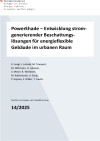
Ziel des Projektes "PowerShade" war die Entwicklung von kostengünstigen und universell einsetzbaren stromgenerierenden Beschattungslösungen, welche durch intelligente Regelung gekoppelt mit künstlicher Intelligenz eine Steigerung der Energieflexibilität von Gebäuden im urbanen Raum ermöglichen.
Schriftenreihe
14/2025
D. Sengl, J. Leibold, M. Trampert, M. Wittmann, G. Lukasser, S. Moser, R. Weitlaner, M. Kobelrausch, A. Estaji, Z. Kujawa, S. Wilker, T. Sauter
Herausgeber: BMK
Deutsch, 62 Seiten
Downloads zur Publikation
Cooling LEC – Energieflexible Gebäude durch Steuerung von Kühlanlagen über unidirektionale Kommunikation in Local Energy Communities
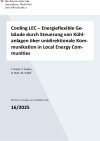
An das Stromsystem (insbesondere an das Verteilnetz) werden in Folge des Klimawandels und des Temperaturanstieges insbesondere durch den Anstieg aktiver Kühlsysteme vor allem auf Niederspannungsebene neue Herausforderungen gestellt. Durch die hohe elektrische Leistung von aktiven Kühlaggregaten und die hohe Dichte an Anlagen, die mitunter unkoordiniert und zu ungünstigen Zeitpunkten betrieben werden, entstehen Verbrauchsspitzen im System. Das Projekt Cooling LEC weist daher als übergeordnetes Ziel die Entwicklung und Demonstration einer zentralen Steuerung / Intelligenz von dezentralen aktiven Kühlanlagen über eine Weiterentwicklung der unidirektionalen Kommunikation von Rundsteueranlagen zur Schaffung energieflexibler Gebäude im Sinne des neuen Ansatzes der "Local Energy Communities” durch Schaffung eines "Sondertarifs"aus. Rundsteueranlagen sind seit vielen Jahrzehnten etabliert und bei allen Energieversorgern vorhanden sowie bewährt. Das Upcsaling-Potential ist sehr groß.
Schriftenreihe
16/2025
T. Nacht, R. Pratter, N. Bisko, M. Kröpfl
Herausgeber: BMIMI
Deutsch, 54 Seiten
Downloads zur Publikation
mAIntenance – Untersuchung von KI gestütztem Instandhaltungs- und Energiemanagement
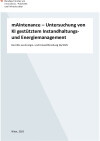
Optimierter & zuverlässiger Betrieb von Heizungs-, Lüftungs-, Klima- und Kältetechnik (HLKK) Anlagen hinsichtlich Instandhaltungs- und Energiemanagement mittels prädiktiver, datenbasierter & selbstlernender Fehlererkennung. Konzeptioneller Entwurf und prototypische Implementierung eines KI (Künstliche Intelligenz)-Tools zur automatisierten Datenanalyse und Empfehlungsgebung für das technische Gebäudemanagement.
Schriftenreihe
46/2025
Jerik Catal, Fabrizia Giordano, Jan Kurzidim, Michael Schöny, Miloš Šipetić, Thomas Lachmayer, Anna Maria Nujic
Herausgeber: BMIMI
Deutsch, 75 Seiten
Downloads zur Publikation
greening UP! Nachhaltige Grünpflege, Wartung, Instandhaltung von Vertikalbegrünungen inklusive rechtlicher Aspekte
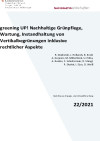
Im Projekt wurden aufbauend auf umfassenden Erhebungen und Analysen von bestehenden vertikalen Gebäudebegrünungen in Außenräumen (boden- und systemgebundene Fassadenbegrünungen) und vertikalen Innenraumbegrünungen passgenaue Grünpflege-, Wartungs- und Instandhaltungskonzepte erarbeitet und rechtliche Aspekte adressiert. Der "greening UP!"-Wissenspool mit konkreten Empfehlungen und anschaulich aufbereitetem Wissen sowie die Konzeption eines digitalen Tools zur "Ersten Grünen Hilfe" runden das Projekt ab.
Schriftenreihe
22/2021
R. Dopheide, J. Hollands, B. Knoll, A. Korjenic, M. Mitterböck, U. Pitha, A. Renkin, F. Schiefermair, R. Stangl, P. Skolek, I. Süss, O. Weiß
Herausgeber: BMK
Deutsch, 162 Seiten
Downloads zur Publikation
Technology Platform Photovoltaic Austria
Between research institutions and the economic system the way has been paved to initiate joint R&D projects. Common research activities have been initiated and intensified to be able to position local companies in international niche markets for photovoltaics.
Vertical Farming: Ermittlung der Anforderungsbedingungen zur Entwicklung eines Vertical Farm-Prototyps zur Kulturpflanzenproduktion
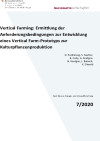
Im Mittelpunkt stand die Erforschung von Grundlagen für eine neue Gebäudetypologie, der Vertikalen Farm. Urbane vertikale Lebensmittelproduktion kann zur Steigerung der Energieeffizienz von und zur Reduktion des Landverbrauchs durch Städte beitragen. Wesentliche Einflussfaktoren zur Erreichung dieser Ziele werden durch diese Grundlagenforschung offen gelegt.
Schriftenreihe
7/2020
D. Podmirseg, S. Sautter, B. Cody, A. Keutgen, N. Keutgen, J. Balasch, K. Diwold
Herausgeber: BMK
Deutsch, 91 Seiten
Downloads zur Publikation
Potenzialstudie von Popcorn-Technologien für das österreichische Energiesystem
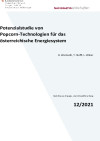
Der Bericht dokumentiert die Ergebnisse des Projekts „Popcorn-Technologien“. Systematisch wird versucht, in die langfristige Zukunft von Technologieentwicklung, Wirtschaft und Gesellschaft zu blicken. Aufkommende Technologien und radikale Innovationssprünge werden identifiziert, die einen ökonomischen und/oder sozialen Nutzen bringen.
Schriftenreihe
12/2021
H. Warmuth, T. Steffl, L. Zillner
Herausgeber: BMK
Deutsch, 72 Seiten
Downloads zur Publikation
Technologieplattform Photovoltaik Österreich
Zwischen Forschungseinrichtungen und der Wirtschaft wurden die Grundsteine für gemeinsame F&E-Projekte gelegt; gemeinsame Forschungs-Aktivitäten wurden initiiert bzw. verstärkt, um diverse heimische Betriebe als wesentliche globale Innovationsmotoren in ausgewählten Nischenbereichen dauerhaft am internationalen PV Markt positionieren zu können.
Entwicklung eines Passivhaus-Vollholzfensters
Auf Basis der Erfahrungen mit Niedrigenergiefenstern wird ein Passivhausfenster aus Vollholz entwickelt
Technologiereport: Digitalisierung der Bau- und Immobilienbranche
In der Vielzahl digitaler Möglichkeiten ist es nur sehr schwer möglich, einen Überblick zu behalten, Trends und Potentiale abzuschätzen sowie Zusammenhänge zu erkennen. Der vorliegende Report zielt daher darauf ab, den aktuellen Stand der Technik und die Markteinschätzung vielversprechender digitaler Technologien zu beschreiben. Es werden Informationen über konkrete Anwendungsfälle, Mehrwert und Herausforderungen der jeweiligen Technologien bereitgestellt. Die dargestellten Analysen dienen der Potentialbewertung und der strategischen Weichenstellung zur Integration der aktuell wichtigsten digitalen Technologien der Bau- und Immobilienbranche.
DW² - Entwicklung einer thermisch verbesserten Schlitzwandkonstruktion
Die thermischen Eigenschaften von Schlitzwandkonstruktionen werden durch die Anwendung neuer Materialien und Herstellungsmethoden verbessert und durch Labor- und Feldversuche validiert sowie durch numerische und ökologische Betrachtungen ergänzt. Das Ergebnis kann bei der Errichtung von energetisch verbesserten unterirdischen Bauwerken wie beispielsweise Tiefgaragen oder zur Herstellung von Erdwärmespeichern verwendet werden.
DW² - Thermal improvements on diaphragm walls
New materials and installation methods for diaphragm walls will be investigated in laboratory and field tests in order to improve the thermal properties of the construction elements. Additional numerical and ecological aspects are considered to ensure an energetic enhancement of underground constructions such as underground garages or thermal energy storages.
HotCity - Gamification als Möglichkeit für die Generierung von Daten zur energieorientierten Quartiersplanung
Ziel des Projekts war ein Funktionstest, ob durch Gamification kosteneffizient, rasch und zuverlässig ein aktueller Datensatz von energierelevanten Daten zur Quartiersplanung erhoben werden kann. Dies wurde am Beispiel der Potenzialermittlung von industriellen und gewerblichen Abwärmequellen in Wien und Graz ermittelt.
HotCity - Gamification as a possibility to generate data for energy-oriented neighbourhood planning
The aim of the project was a functional test to determine whether an up-to-date data set of energy-oriented data can be collected for neighbourhood planning through gamification, cost-efficiently, quickly and reliably. This had been determined using the example of the potential determination of industrial and commercial waste heat sources in Vienna and Graz.
BiBi-TGA - Potenzial der ökologischen Optimierung technischer Gebäudeausrüstung durch den Einsatz biogener Materialien
Erhebung des Substitutionspotenzials herkömmlicher Komponenten der technischen Gebäudeausrüstung durch biogene Materialien. Ziel war die Generierung neuer Daten zum ökologischen Verbesserungspotenzial des Einsatzes biogener Ressourcen in der technischen Gebäudeausrüstung in Bürogebäuden. Anhand von LCA-Screenings und Untersuchungen der technischen Umsetzbarkeit wurden die Potenziale analysiert.
BiBi-TGA, Potential for the ecological optimization of technical building equipment through the usage of biogenic materials
Assessment of the substitution potential of conventional components of technical building equipment by biogenic materials. The aim is to provide new data on the ecological improvement potential of the usage of biogenic resources in the technical building equipment in office buildings. The potentials are analyzed by means of LCA screenings and technical feasibility studies.
Multi-WP - Hocheffiziente multivalente Wärmepumpenkonzepte zur thermischen Nutzung von Außenluft mit geothermischer Speicherung
Optimierung von Multi-WP-Systemen bestehend aus Luft-Wärmepumpen und Erdspeichern im Hinblick auf Erhöhung der Flexibilität und Effizienz ab 30 kW für Einzelgebäude sowie Quartierslösungen und Behandlung von Aspekten wie PV-Nutzungsoptimierung, Betriebsweise, Nutzungskonflikte und Lärmbelastung durch Luftwärmepumpen. Das Projekt wird die Nutzung der Wärmequelle Außenluft in Kombination mit Saisonspeichern als besonders effiziente Alternative für Heizung, Kühlung und Warmwasserbereitung etablieren.
